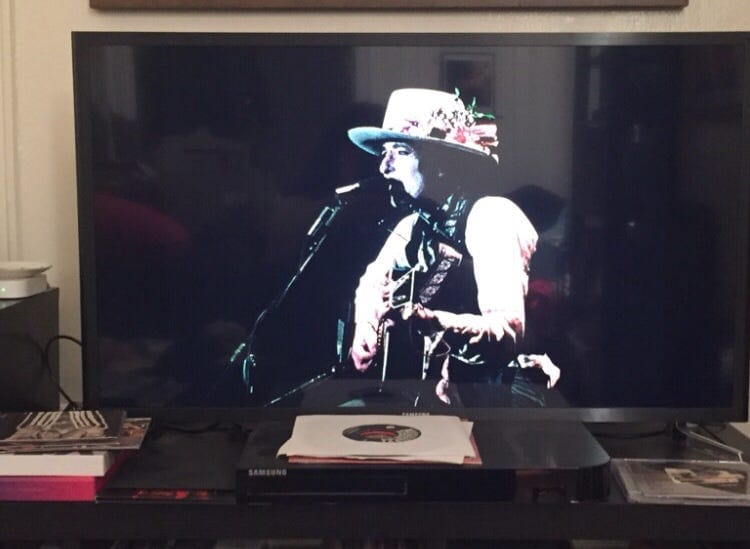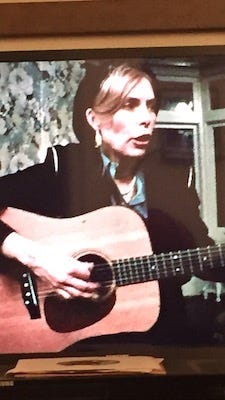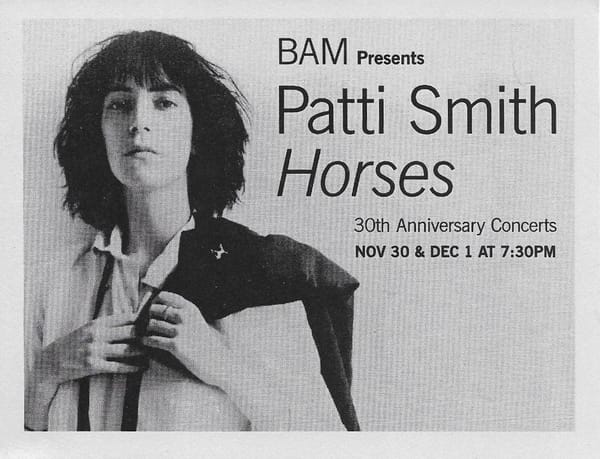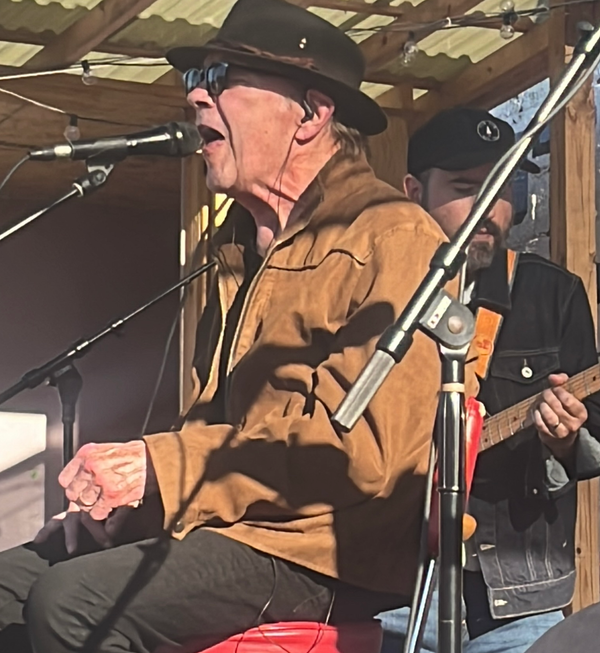Rolling Thunder & Asbury Park: Riot, Redemption & Rock and Roll
i'll know my song well before I start singing.

In the early winter of 1975, I heard a radio spot for a Bob Dylan concert in Waterbury, CT. I then presented my parents with a list of reasons I wanted to see Bob Dylan (“He is an important songwriter,” and some stuff about how the Beatles wanted to meet him). My father explained that I was 11, the household was a benevolent dictatorship, and they were not driving me to Waterbury on a school night to go to a rock concert.
In 1978, I was in a random bookstore when I saw a chunky trade paperback, dark blue with a tiny figure and at the top: On The Road With Bob Dylan. I bought it because I needed something to read and it was about Bob Dylan. I didn’t know that the book was about the tour I never got to see, and none of that even mattered because the book was a lesson and an immersion. I didn’t know that you could write a book like that. I didn’t know this was a job that existed. I was a regular reader of the music press at this time, but this book didn’t read like anything I normally read. It made you feel like you were there. It was a grand, sweeping epic that I fully at age 14 did not understand about a third of, but it stuck with me, hard. I used it as a guidebook for Greenwich Village, hanging out in the Figaro on the corner of Bleecker & MacDougal (it’s empty now, before that it was a Qdoba for about five minutes) because Dylan lived on that block and maybe if I sat there and pretended that I was cool, he might walk by and I would… see him?
I hadn’t thought it out all that much, to be honest.
I have read every word written about the 1975 tour, I have doggedly pursued bootlegs for years, I dragged a poor girlfriend to see Renaldo and Clara with me at the Sono Cinema (RIP) in Norwalk in some limited art house release. And now we have the goddamn holy grail streaming into our very homes, Scorsese’s take on Rolling Thunder. And while I would love nothing better than to just have access to all of the footage from the tour, or at least, please god, one entire show from end to end, Scorsese has given us … enough.
Maybe.
Renaldo and Clara was unwatchable as a coherent piece of art, at least to my memory of my one cinematic viewing and various chances at watching shitty VHS copies. And if you’re read anything about the filming of the tour (Sam Shepard’s logbook is your source here), you will learn how the film crew mostly missed most of the offstage antics, both real and staged, that they were supposed to have been shooting. Additionally, at least according to Andy Greene in Rolling Stone, guess what? THE FUCKING MASTER IS LOST.
But what they did get was, at least, enough of Dylan onstage with that band, and you can count on Martin Scorsese to give you entire songs from end to end. And so you get to watch that searing performance of “Isis,” Bob waving his hands in the air and illustrating “the world’s biggest necklace,” Bob in the white face paint and the kohl-rimmed eyes.
There are a lot of shots of Dylan’s eyes in this film, and for good reason: they say everything and then some. Watch his expression when he’s singing. Watch his eyes when he’s in that scene at Mama’s Dreamway Lounge with Joan Baez, who’s wearing a beaded wedding dress that was just given to her by the ancient owner of this hole in the wall in Springfield, MA, which just happens to fit Baez perfectly. Like Sam Shepard says in his Rolling Thunder Logbook, “This is turning into either the worst melodrama on earth or the best head-to-head confessional ever put on film,” and he’s right that it doesn’t matter which one it is, because if that moment doesn’t make the hair on your arms stand up and look at the television and go eeeeeeeekkkkkkkkomgomg … okay, that was how *I* reacted, and I’ve *seen* that scene before (it’s in R&C). “I married the woman I love,” Bob says, not wearing a wedding ring and knowing his marriage is ending.
Of course I am not going to be writing this newsletter without talking about the appearance of Patti Lee Smith, and as someone who has for years tried to chase down recordings of that performance with Eric Andersen at Folk City (Folk City! on W. 4th St! You can see the Waverly, now the IFC Center, down at the end of the block. That red flocked wallpaper!!) where she is nervous and she stumbles and then she finds the thread and locks it in and there was no way you couldn’t pay attention, especially if you’re a poet who put your words to rock and roll.

Watch Dylan’s eyes while Patti is talking to him in that scene at the party in his MacDougal Street townhouse.
There are so many eyes.
I am a cheering section for Larry “Ratso” Sloman, because his book was a major reason I realized I could possibly ever write about music, and it still colors my work to this very day. There is an energy and a color and a sense of movement that comes when a journalist is seeing multiple performances on a tour that is not the same perspective if you are just seeing one show per tour when they arrive in Your Town, but there are also zero publications who are going to send a journalist out to do that, and there are very few if any bands who are going to let a journalist come along for the ride like that. And yes, Sloman complains that he was asked to come on the tour and then wasn’t given access, but even with that lack of access, he still had plenty of access to write the actual story, which was the country and the fans and the music that was happening onstage every single night.
You think that one song from Joni Mitchell isn’t enough, and no, it isn’t enough, but it is also everything we needed to see, the moment when “Coyote” comes to life. Larry Sloman has some great color of the scenes where she is putting the song together--you see a bit of this, a scene on the train where she’s working out the lyrics on hotel stationery -- and now we get to see her put it to life. Again, watch Dylan’s eyes in this scene. It is respect and it is also incredulity and it is also, shit, this woman is my goddamn competition.

I’ve watched it four times by the time I sat down to write this; I went to see it in the theater on the Upper West Side last night, which was actually more perfect than I even realized, the assorted gray haired former renegades snickering appropriately are the same ones who blissfully dance in the aisles at the concerts during the summer at Lincoln Center Out of Doors. Tonight I had to forward past Sharon Stone and some of the other faux mockumentary footage, so while I tip my cap to the concept behind it, I don’t know how I’ll feel about it in a year. I’ll let you know after I watch it another handful of times, which I am guaranteed to do.
On the documentary tip, I went to one of the theatrical screenings of the latest cut of Asbury Park: Riot, Redemption & Rock and Roll. I saw the original cut at the AP film festival in 2017, and thought quite highly of it at the time, mostly because it didn’t stint on the v. racist backstory of the town and the riot, and that it centered the local community and historians. I’m thrilled that Bruce saw value in the film and agreed to participate (which, of course, gave everyone else that was hanging back a green light), but now the movie centers on him, instead of its original mission of explaining the history of Asbury Park and why it fell apart the way it did, and the role music had in that.
Most of the footage of the (black) historians and (black) community activists is gone, and their voice is severely diminished. Now, it’s basically a documentary about the Upstage--which, don’t get me wrong, is something that should exist--but what has now happened with this cut is exactly what has happened in Asbury Park time and time again. It’s now another illustration of the historic division between the East Side and the West Side. How can you even say “for reasons that aren’t quite clear” as any kind of definitive declaration about why the riots started? What kind of hand-wav-y, insensitive, caucasity is going on here? How do you manage to avoid facing the fact that Springwood Avenue is STILL empty, 50 years later? How can you not be impacted by that? How can you just keep showing the same stock footage over and over and over?
Asbury’s story isn’t pretty and its comeback is great, but none of it is reaching the West Side for the people who live there. None of it. Which is the Asbury Park story, over and over again--which the filmmakers ditched because they had Bruce on camera now. Additionally, the film is poorly edited; many of the sidemen who were interviewed did not need to be there; and the tone of the narrator’s voice is overwhelming, and deeply ill-suited to this type of project.
Since I said the “S” word I will note that I got a late assignment for Western Stars and I have to write and file that before I can write about it more generally, so look for something on the album in about a week in this venue (and others).




